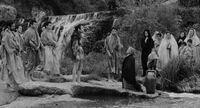On a black and white poster of Matthew's Gospel, St. John is kissing Jesus' face affectionately.
In this fixed frame, the image of the Son of God is refreshing - not "splendid", and it seems that it is not enough to "illuminate the people of all nations." It is not like the ascetic on the religious murals, showing the skinny aging and vicissitudes of life. On the contrary, the Jesus in the film is quite young (the actor is only 19 years old), tall, very thin, pale, with deep outlines, dark eyebrows and eyes, looking very melancholy and very solemn.
It is worth mentioning that the profile of that St. John is quite similar to Pasolini. As for whether this was deliberately arranged, it is unclear. However, it is certainly not a coincidence that such an ambiguous still photo was chosen. Obviously, as a "notorious" homosexual, this self-expression and projection of Pasolini is blatant.
According to rumors, as a poet Pasolini was attracted by the text of "Matthew's Gospel" because of an accident, and decided to make a poetic religious film. However, the ancient Gospel of Matthew is really too beautiful a poem. In the end, Pasolini sighed with regret: "In terms of poetry, the image can never reach the height of the original!"
In fact, the image I've always been inclined to think that Matthew is one of the coolest and purest religious films in film history, with the exception of Dreyer's Joan of Arc. Even the crucifixion in Tarkovsky's "Andrei Rublev", when compared, shows too much tenderness.
The root cause may be as Roger Albert said: "Because he didn't believe in God, he didn't preach, he didn't praise, he didn't deliberately emphasize, or sentimentalized and romanticized the story, but just tried his best to record it."
From this level, Pierre Paolo Pasolini is really a very terrible director. "The Gospel of Matthew", from the title shows absolute loyalty to the original. There is no need for a script book, or even an exhaustive script. It is enough to bring a copy of "The New Testament. The Gospel of Matthew" with a total of twenty-eight chapters.
Because, the dialogue in the film is almost completely copied from the original, without changing half a word. As for the characters, most of the time, they are dressed in medieval sackcloth and move slowly and disorderly in the vast space. The camera sometimes cuts to the blank, expressionless faces of the characters, who are extremely quiet and reticent.
These symbolic images may collide with the "movie of poetry" in Patriarch's concept. He sets up the camera and stares silently on the wasteland, in front of human faces, any explanation becomes superfluous. When the picture is not enough to express, the subtitles will calmly type out the original text (actually the storyline). At the same time, Bach's Mass in B Minor and the Passion of Matthew poured out on the soundtrack, which is not exciting, but a little tragic.
What is incredible is that it is this kind of expression that does not seem to be expressing sincerity, but actually presents an unusually sacred feeling. Jesus led the twelve disciples. There was no miracle, just a lonely walk on the vast wasteland. When a group of ragged believers silently rushed forward, the pure, rough and primitive texture made people feel Immediately moved to tears.
In fact, Pasolini did not have much real faith-based reverence for Christ. I believe that his reverence was more about the concept of naked beauty. The Jesus in his mind and Derek Garman's Sebastian are actually no different, both are symbols of desire or revolution.
He clearly knows that he is just borrowing a sublime thing, a most sacred shell to reproduce his ideal country and utopia, and at the same time to complete his modernist and extremely realistic aesthetic pursuit. Other than that, the so-called God is nothing.
As a well-known atheist, Pasolini once said something like this, which probably means that I am a complete non-believer, but I miss the belief itself very much. Then he said, "I believe in Marx, I believe in sex, I believe in freedom, I believe in revolution, I believe in aesthetics, I believe in extreme violence and abuse, I believe in everything I think I should believe in."
So he poured all his beliefs into it. In a film like this, the irony is that none of it is about religion, although in some ways, perhaps, this is a real touch that touches the original, the sublime, the insulted and the damaged of divine works.
Finish
View more about The Gospel According to St. Matthew reviews











